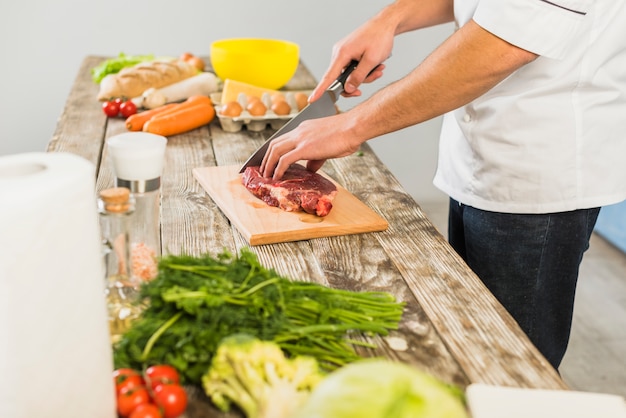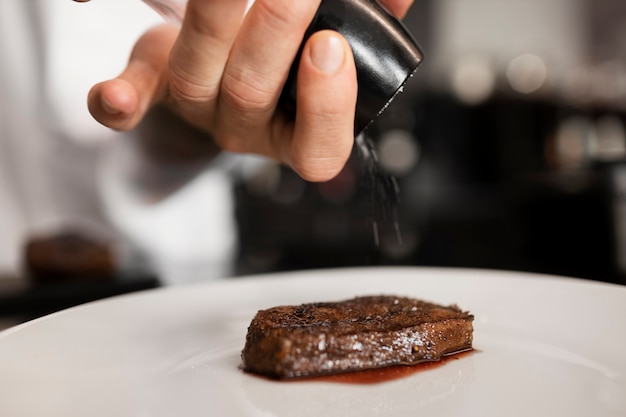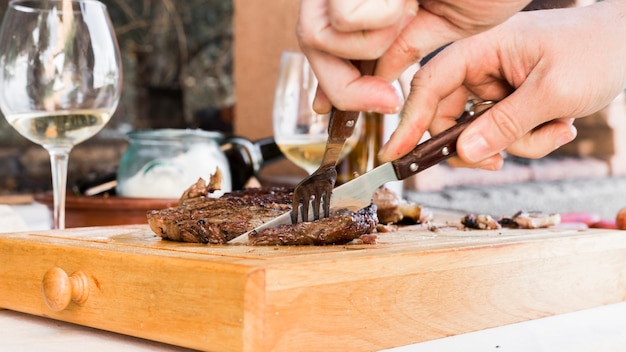(Part 1) Getting Started: Choosing the Right Cut

The Classics
- Sirloin: A classic for a reason, sirloin is known for its marbling and flavour, which translates to a tender and juicy steak, even when cooked to medium-well. It's also a bit more forgiving than some other cuts if you happen to overcook it a little. You'll find this cut commonly served at pubs and restaurants.
- Rib-eye: This steak is a real crowd-pleaser. It boasts a rich flavour and buttery texture, thanks to its generous marbling. For a more even cook, choose a thicker cut. However, remember, rib-eye is a bit more delicate than sirloin, so I wouldn't recommend it for beginners. It's perfect for a special occasion or when you want to impress your guests.
- new york strip: This steak is a favourite among steak connoisseurs. It has a nice, even thickness, making it a great choice for a medium-well cook. You can grill it, pan-fry it, or even bake it, and it will always deliver on flavour. It's a bit more delicate than sirloin, so pay close attention to the cooking time to avoid overcooking.
The Alternative
- flank steak: This leaner cut is packed with flavour and can be surprisingly tender when cooked right. It's best for marinating and is perfect for slicing thinly. I love using flank steak for stir-fries or fajitas, but I know some grill masters love to grill it too. It's a good choice if you want to have a bit of a challenge and a delicious, flavorful steak.
(Part 2) Prepping Your Steak: A Symphony of Flavour

Seasoning: The Key to Unveiling Flavour
- Don't underestimate the power of salt and pepper. It may seem simple, but a good dose of both will bring out the natural flavour of the steak. Don't be shy with the seasoning, especially salt, which will help draw out moisture and create a nice crust.
- If you're feeling adventurous, try adding other spices like garlic powder, onion powder, paprika, or even a pinch of cayenne pepper for a bit of heat. I love to experiment with different combinations, but keep it simple for a first-time try.
- For an extra layer of flavour, try rubbing the steak with olive oil. You'll get a nice, crispy crust and a juicy interior. You can also use a marinade for added depth of flavour, but don't overdo it. A simple marinade of soy sauce, olive oil, garlic, and herbs will suffice.
Bringing Your Steak to Room Temperature: A Crucial Step
- This might sound counterintuitive, but letting your steak come to room temperature before cooking can actually help you get a more evenly cooked steak. It allows the internal temperature to even out, so you won't have a cold centre and overcooked edges. I've learned this the hard way, especially when grilling steaks on a hot day.
- If you're pressed for time, you can always try to achieve this by placing your steak on the counter for 15-20 minutes before cooking. Just make sure it's not in direct sunlight.
(Part 3) Grilling to Perfection: The Art of Char and Smoke

Setting Up Your Grill: A Hot Start
- The key to grilling a medium-well steak is to use high heat. Preheat your grill to high heat, around 450°F (230°C). I usually go for medium-high to make sure the steak sears properly without burning. You can achieve this by using charcoal briquettes or gas burners. If you're using a gas grill, use two burners at high heat, leaving the middle one off. If you're using a charcoal grill, make sure the coals are white-hot and evenly distributed.
- You might want to consider a grill grate with wide spacing, so your steak doesn't fall through. Trust me, I've had that happen, and it's not a good look.
Grilling Your Steak: Patience is Key
- Once your grill is hot, place the steak on the grill and cook for about 3-4 minutes per side for a medium-well steak. The exact time will depend on the thickness of the steak. If you're using a meat thermometer, aim for an internal temperature of 145°F (63°C). You'll know the steak is ready when it's nicely browned and has a slight resistance when you press on it.
- For that perfect sear, don't move the steak too much during cooking. I know it's tempting to flip it around every two minutes, but resist the urge. Let it cook undisturbed for a while. The more you move it, the more likely you are to end up with a dry steak.
- To ensure even cooking, try grilling the steak over indirect heat for the last 3-4 minutes. This will help the steak cook through without burning the outside. Just move it to a cooler part of the grill or use a heat diffuser.
(Part 4) Pan-Frying Your Steak: A Delicious Indoor Option
Alright, now for pan-frying, a more manageable and suitable option for smaller spaces. It's a great alternative to grilling, and it can be just as delicious.Getting Your Pan Ready: The Hot Pan Equation
- Choose a heavy-bottomed pan or skillet, preferably cast iron, and heat it over high heat. A good, hot pan is key to achieving that beautiful sear. And don't forget to add some oil; I usually go for a good quality olive oil or avocado oil.
- When the pan is hot, you'll see the oil shimmering. It should be hot enough for a drop of water to sizzle immediately when you add it to the pan.
Pan-Frying Your Steak: Mastering the Technique
- Now, gently place the steak in the hot pan and let it cook undisturbed for 3-4 minutes per side for a medium-well steak. Remember, we're aiming for that beautiful sear, so don't flip it too often. If you find yourself fidgeting, just put on some music and let the steak do its thing!
- To ensure even cooking, you can try reducing the heat to medium-high after the initial searing. I find it helps create a more even internal temperature.
- Use a meat thermometer to check the internal temperature of the steak. You should aim for 145°F (63°C) for medium-well. Once it reaches the desired temperature, remove it from the pan and let it rest for 5-10 minutes before serving.
(Part 5) Baking Your Steak: A Beginner-Friendly Approach
Okay, you might be thinking, "baking a steak? Really?" But trust me, it's a great way to get a perfectly cooked steak, especially if you're a beginner. It's less intimidating and more forgiving than other methods.Preparing Your Steak for the Oven: A Simple Setup
- Preheat your oven to 400°F (200°C). Don't forget to season your steak, just like we did for the other methods. You can also add some olive oil for a nice crust.
- Place the steak on a baking sheet and place it in the preheated oven.
Baking Your Steak: The Gentle Approach
- For a medium-well steak, bake the steak for about 15-20 minutes, depending on the thickness. I recommend using a meat thermometer to ensure accuracy. You're aiming for an internal temperature of 145°F (63°C).
- When the steak is cooked, remove it from the oven and let it rest for 5-10 minutes before serving. It allows the juices to redistribute, so you'll have a juicy and tender steak.
(Part 6) The Art of Resting: A Crucial Step in Steak Perfection
Alright, so you've cooked your steak perfectly. It's time to take a deep breath, because now it's time to rest the steak. I know it's hard, but resist the urge to dive straight into your culinary masterpiece.Why Resting is Important: A Culinary Secret
- Resting allows the juices to redistribute evenly throughout the steak. The steak will become more tender and juicy. It's a crucial step in ensuring you get that perfect, tender, and flavorful steak.
- It's also a chance to let the steak cool down slightly. You'll want to avoid that awkward moment where you burn your mouth on a super hot steak.
How to Rest Your Steak: The Proper Technique
- After cooking, transfer the steak to a cutting board and cover it loosely with foil. Let it rest for 5-10 minutes before slicing and serving. It's best to resist the urge to slice it immediately.
- You'll know it's ready when the internal temperature has stabilized. It's also a good idea to check the juices running out. If they're clear, it's ready to serve.
(Part 7) Temperature and Doneness: Understanding the Science Behind Steak
Now, let's talk about the science behind steak doneness. You might have heard about rare, medium-rare, medium, medium-well, and well-done. But what does it actually mean? Well, it all boils down to the internal temperature of the steak.The Doneness Chart: A Guide to perfect steak
- This table outlines the different levels of doneness and their corresponding internal temperatures. It can be a useful guide to help you determine how long to cook your steak to reach your desired level of doneness.
| Doneness | Internal Temperature (°F) | Internal Temperature (°C) |
|---|---|---|
| Rare | 125-130 | 52-54 |
| Medium-rare | 130-135 | 54-57 |
| Medium | 135-140 | 57-60 |
| Medium-well | 140-145 | 60-63 |
| Well-done | 145 | 63 |
- You should always aim for an internal temperature of at least 145°F (63°C) to ensure that the steak is cooked safely. I know that well-done steaks have a bad reputation, but it's crucial to ensure proper food safety.
(Part 8) Cooking Times for Different Thicknesses: A Detailed Guide
Okay, so we've covered the basics. Now let's delve into the specifics: cooking times for different thicknesses.Steak Thickness and Cooking Time: A Crucial Factor
- The cooking time for a steak will vary depending on its thickness. Thicker steaks will take longer to cook than thinner steaks. Remember, we're aiming for medium-well, which means a core temperature of 140-145°F (60-63°C).
Cooking Time Guide: A Practical Tool
- Here's a general guide for cooking times for medium-well steaks of different thicknesses:
| Steak Thickness (inches) | Approximate Cooking Time (minutes per side) |
|---|---|
| 0.5-0.75 | 3-4 |
| 0.75-1 | 4-5 |
| 1-1.25 | 5-6 |
| 1.25-1.5 | 6-7 |
| 1.5 | 7-8 |
- Remember, these are just estimates. The exact cooking time will depend on the type of steak, the heat of your grill or pan, and other factors. It's always best to use a meat thermometer to ensure accuracy. And remember to let the steak rest for 5-10 minutes after cooking.
(Part 9) FAQs: Addressing Your Steak-Related Questions
- What’s the best way to tell if a steak is medium-well done?
You can tell by the appearance and feel of the steak. It should be nicely browned on the outside and have a slight resistance when you press on it. You can also use a meat thermometer to check the internal temperature. For medium-well, aim for an internal temperature of 140-145°F (60-63°C).
- What happens if I overcook my steak?
If you overcook your steak, it will become dry and tough. It's important to pay attention to the cooking time and use a meat thermometer to ensure that the steak doesn't overcook.
- Can I use a meat thermometer for grilling?
Yes, definitely. A meat thermometer is the most reliable way to determine the internal temperature of your steak. It’s a good investment for any grill master, especially beginners.
- What’s the best way to serve a medium-well steak?
I personally love to serve a medium-well steak with a side of roasted vegetables, mashed potatoes, or a salad. It’s also great with a simple pan sauce or gravy. It's your culinary playground, so go wild and have fun!
- Can I reheat a medium-well steak?
It’s not recommended to reheat a medium-well steak. It will become dry and tough. If you have leftovers, it’s best to eat them cold or use them in another dish.
Everyone is watching

Corn on the Cob: The Ultimate Guide to Perfectly Cooked Ears
Healthy MealsAh, corn on the cob. Just the name evokes images of sunny days, barbecues, and that sweet, juicy flavour that ...

Scallops: The Ultimate Guide to Perfect Cooking
Healthy MealsAh, scallops. Those delicate, sweet, and utterly delicious morsels of the sea. They hold a special place in my...

Spaghetti Squash: The Ultimate Guide to Cooking and Serving
Healthy MealsRemember that time you saw spaghetti squash at the supermarket, looking all bumpy and strange, and thought, "W...

Salmon Cooking Times: Perfect Guide for Every Recipe
Healthy MealsLet me tell you, cooking salmon is an art form. It's all about getting that perfect balance: juicy and tender,...

Ham Cooking Time: How Long to Bake, Smoke, or Boil a Delicious Ham
Healthy MealsAh, ham. It's a classic, isn't it? A real crowd-pleaser, especially around holidays. And when done right, it'...
